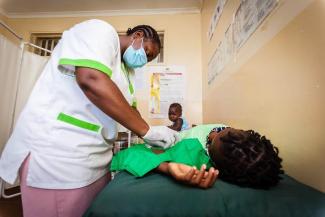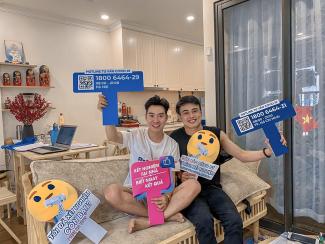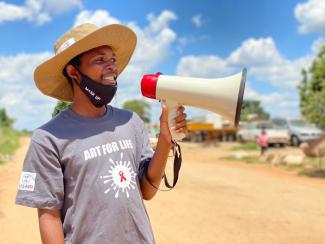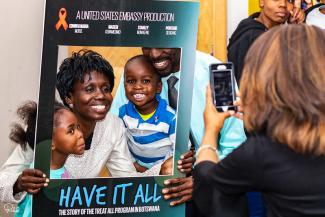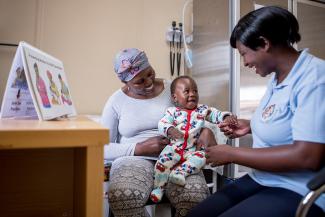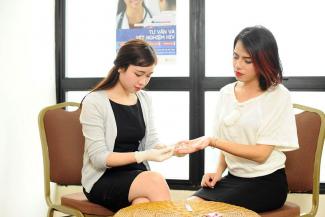Through our dedicated staff around the world, host country governments, the private sector, philanthropic organizations, multilateral institutions, civil society and faith-based organizations, people living with HIV, and with the strength of our programs, we are well positioned to advance human rights, address inequality, and end HIV as a public health threat by 2030. Each department and agency that implements PEPFAR globally brings its own unique expertise to the HIV response.
USAID has made significant strides and been a leader in the following areas over the last 20 years.
Supporting Adolescent Girls and Young Women Through DREAMS
Adolescent girls and young women face a higher risk of HIV infection due to factors like social isolation, poverty, discrimination, orphanhood, gender-based violence, and inadequate schooling. The DREAMS (Determined, Resilient, Empowered, AIDS-free, Mentored and Safe) partnership aims to reduce rates of HIV among adolescent girls and young women and promotes the economic empowerment of girls and young women to prevent the spread of HIV. USAID is the lead implementer of DREAMS in both funding and geographic reach. The DREAMS program provides tailored services such as HIV and violence prevention training, education support to complete secondary school, financial literacy, links to employment, HIV prevention medication (pre-exposure prophylaxis or PrEP) and family planning services. Last year:
- USAID contributed to reaching more than two million adolescent girls and young women (AGYW) through DREAMS programming, representing 84% of the total number of AGYW supported by PEPFAR.
- USAID’s DREAMS programs provided more than 1.4 million AGYW with family planning counseling, contraceptives, and referrals.
- USAID’s DREAMS programming contributed to providing 373,770 AGYW with economic strengthening interventions, which empower participants with the technical skills and networks to become entrepreneurs or be linked to wage employment.
Learn more about the DREAMS program and,
- Read how the DREAMS program empowered Mapesho to start her own small business.
- Read how DREAMS Ambassadors are helping to reduce the spread of COVID-19 among the people of Lesotho.
- Read how the DREAMS program is helping young women like Gcinile to access the HIV-prevention method PrEP.
Supporting Orphans and Vulnerable Children
Children and adolescents face significant risks and vulnerabilities as a result of the HIV/AIDS epidemic. Globally, an estimated 13.8 million children ages 0-17 have lost one or both parents due to AIDS and an estimated 1.8 million children ages 0-14 are living with HIV, but only 53% of these children receive treatment.
USAID’s orphans and vulnerable children (OVC) program contributes to ending the HIV epidemic by not only connecting children living with HIV to treatment and helping them to remain on treatment, but also by providing highly vulnerable and at-risk children and families with HIV prevention, health, and social services through community and household support. USAID and our partners provide families with tailored, comprehensive health services as well as household economic strengthening, education support, and child protection services through trusted care workers.
In 2022, USAID supported nearly six million orphans, vulnerable children, and their families affected by HIV with critical services, such as household economic strengthening, education support, parenting skills building, and facilitating access to maternal and child healthcare and HIV specific testing, care, and treatment.
Learn more about USAID’s OVC program and,
- Read how USAID supports children living with HIV in Uganda.
- Read how USAID is helping children living with HIV in Zambia to stay on treatment.
- Read how USAID supported social workers in South Sudan are helping adolescent girls and young women access equal health, social, educational, and employment opportunities.
Supporting Key Populations
Key Populations (KP) include sex workers, gay men and other men who have sex with men, transgender people, people who inject drugs, and people in prisons and other enclosed settings. Globally, greater proportions of these populations are living with HIV due to certain risk behaviors, marginalization, and structural factors such as stigma, discrimination, violence, human right violations, and criminalization. These barriers restrict access to and use of critical HIV services.
Twenty years ago, programs that serve key populations were hidden due to stigma and discrimination. Today, USAID and its partners support almost two million members of key populations in 45 countries with HIV prevention services and supportive interventions.
USAID implements programs that engage these key populations and provide them with more accessible access to HIV prevention, testing, and care services. In 2022,
- More than 275 thousand members of key populations in 41 countries received life-saving HIV medication through USAID support.
- USAID initiated HIV prevention medication, Pre-Exposure Prophylaxis (PrEP), in almost 230 thousand members of key populations.
Learn more about USAID’s work to support key populations and,
Addressing Gender-Based Violence
Gender-based violence (GBV) refers to harmful acts directed at an individual based on their gender. Gender inequality and GBV constrain efforts to reach HIV epidemic control. Globally, 35% of women experience intimate partner violence or non-partner sexual violence in their lifetime and women who experience intimate partner violence are 1.5 times more likely to acquire HIV.
USAID implements programs that identify and respond to the unique needs of women, men, girls, boys, and those of other gender identities – of all ages and abilities and in all their diversity – so they can equally access and use HIV prevention and treatment services; protect themselves and practice healthy behaviors; exercise their rights; and live free from violence, stigma, and discrimination.
Today, USAID provides integrated gender-based violence clinical services in 23 countries, including post-violence care services for almost 430 thousand survivors.
Learn more about USAID’s work to address gender-based violence and,
- Read how USAID is advancing gender equity and equality.
- Read how USAID is addressing gender-based violence in Eswatini.
Powering Sustainable Financing
As many of USAID’s partner countries approach sustained epidemic control, we share a responsibility to ensure the financial sustainability of programs providing life-saving services to people living with HIV/AIDS.
Since 2014 USAID has led the coordination and implementation of PEPFAR’s Sustainable Financing Initiative (SFI), which aims to strengthen the public financial management, advance private sector engagement, and mobilize greater resources for the HIV/AIDS response in our partner countries.
With an investment of $48 million, the USAID-led SFI generated more than $361 million in domestic resources for HIV across 16 countries and two regional programs over six years. This work has created a strong platform for promoting long-term financial sustainability of the global HIV response.
For example, in Tanzania, USAID helped to unlock $7.8 million in private sector financing for private clinics or a 9:1 private / public leverage factor. This investment resulted in a 35% increase in HIV testing, with over 10,000 patients tested and 100% of positive patients linked to care. In Nigeria, USAID engaged private pharmacies to provide life-saving HIV treatment, resulting in reduced client wait times which helped more people stay on HIV treatment.
Learn more about USAID’s work to power sustainable financing.
Strengthening the Supply Chain for Health
USAID-supported supply chains have been instrumental in the U.S. Government’s support of the global HIV/AIDS response and USAID has led PEPFAR’s efforts to provide affordable HIV treatment for millions. In 2005, life-saving HIV treatment cost $1,000 per patient per year, but today, through USAID’s supply chain work, life-saving HIV treatment costs $50 per patient per year. From 2018-2020, USAID led the global transition to the HIV treatment regimen called TLD (Tenofovir, Lamivudine, and Dolutegravir). TLD is considered the gold standard in HIV treatment because it has fewer side effects than other HIV treatments and is proven to rapidly suppress viral load in adult and adolescent patients with HIV. TLD has been especially beneficial for children living with HIV because the treatment is just one small pill and it can be taken with or without food, making it more convenient for children to adhere to their treatment regimen. USAID and its partners have led a global transition to TLD with 15 PEPFAR-supported countries reporting that at least 80 percent of the HIV treatments issued in 2022 were TLD.
At a time when many global supply chain networks were forced to pause services because of the COVID-19 pandemic, USAID-supported supply chains continued to provide critical HIV commodities in over 50 PEPFAR-supported countries and those supply chains were instrumental in the U.S. Government’s response to the COVID-19 pandemic globally. In 2022, USAID-supported projects delivered 35 million COVID-19 related products, including oxygen concentrators, ventilators, personal protective equipment, and lab tests in 43 countries.
Building on lessons learned over the last 20 years, USAID is transforming its global health supply chain program to maximize the availability, quality, and affordability of HIV medicines, diagnostics, and other health products. Importantly, USAID is modernizing and strengthening supply chains in PEPFAR-supported countries so that these countries can manufacture or procure their own HIV commodities.
Learn more about USAID’s supply chain work.
Research
For twenty years, USAID has been a leader in the research and development of safe, effective, and affordable HIV prevention products including products that women can use to protect themselves from HIV, including Oral PrEP, injectable PrEP, new HIV prevention technologies, and a vaccine to protect against HIV. In fact, USAID is the fourth largest donor of HIV vaccine research and development.
USAID has led on the following important research milestones:
- USAID has supported studies in Africa that enabled the discovery of some of the most potent broadly neutralizing antibodies (bNAbs) that can help prevent HIV. Researchers are now testing bNAbs, discovered through USAID support, in trials as potential future products for prevention and/or treatment of HIV and are also playing a key role in guiding the development of HIV vaccine development strategies.
- USAID’s $125 million, five-year USAID Microbicide R&D to Advance HIV Prevention Technologies through Responsive Innovation and eXcellence (MATRIX) award aims to expand HIV prevention options for women by accelerating the research and development of products that women can use to protect themselves from HIV.
- USAID is accelerating the introduction and scale-up of new HIV prevention products for women through the Maximizing Options to Advance Informed Choice for HIV Prevention (MOSAIC) award. USAID supports the introduction and scale-up of newly-approved products to accelerate availability, acceptance, uptake, and impact in PEPFAR programs to ultimately achieve a world where women, especially adolescent girls and young women, can live a life free from HIV.
- Since 2001, USAID has supported thousands of scientists at leading globally recognized research institutions in low- and middle-income countries working on the global effort to design, develop, and test HIV vaccines. Today, USAID partners with the International AIDS Vaccine Initiative (IAVI) through the Accelerate the Development of Vaccines and New Technologies to Combat the AIDS Epidemic activity (ADVANCE).
Learn more about USAID’s research and development work and,
- Meet the USAID-supported scientists at the forefront of developing an HIV vaccine.
- Learn about USAID’s work to develop an HIV vaccine over the last 25 years.
- Read how USAID engages advocacy groups to introduce new HIV prevention products.
Through our dedicated staff around the world, host country governments, the private sector, philanthropic organizations, multilateral institutions, civil society and faith-based organizations, people living with HIV, and with the strength of our programs, we are well positioned to advance human rights, address inequality, and end HIV as a public health threat by 2030.
